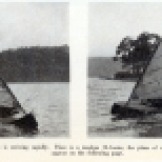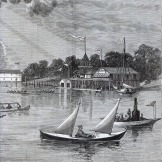One of the most useful tools for beveling the laps is a bullnose rabbet plane, here a Stanley #90. Unlike a regular plane, the iron of the bullnose rabbet plane goes right out the edge of the sole, so you can keep it right on the pencil line. Its sole also just happens to be close to the same with as the lap bevel on this boat.
At each bulkhead/frame, wood is removed until the straightedge lies flat with its upper edge touching the penciled lap line. You need to be careful not to take off too much, which you can see I’m just on the verge of doing here. The thickness of the bottom edge will depend on the shape of the boat’s hull. Here, the bottom becomes a feather edge. If you do that at each known point, it’s then a relatively simple matter to connect these bevels with a smooth transition. Unless you’re making a boat with flush-lap or guideboat-lap planking, all of the beveling takes place on the lower plank.
We’re back to spiling now. The middle planks will go on in one piece, so the spiling batten goes full length.
The second plank is clamped in place to check for fit. If you’ve done a good job ofspiling, it will just touch the lap line and the marks on each frame/bulkhead showing the lower edge. The next round of fastenings will go in the upper edge of this plank, through the 5/8” lap of the plank below it, and be clenched on the inside of the boat.
In order to do the clench-nailing, we need to clamp the plank in place, but the edge we need to clamp is about 5 ½” away from the lower edge, and most clamps don’t have a deep enough throat to reach. We need lap clamps. These may be for sale somewhere, but everyone I know makes their own. I took a couple of hours one afternoon and made up half a dozen from some scrap cherry left over from the paddle project. They’re hinged at the butt end, sometimes with leather but here with little metal hinges, and the middle is just a carriage bolt with a wing nut. These are a medium size with a 6” throat, but you can alter the pattern to make whatever size you need.
Here are some lap clamps in place on the upper edge of the plank. As well as holding the planks together for clench-nailing, they also let you make a final check of how well your laps are beveled.
A lap clamp in action from underneath the boat.
Before fastening the middle plank, we need to mark out the fastening line.
It’s easiest to do this on the bench, using the same gauge we made to mark the plank laps. The laps are 5/8” wide, and we want the fastenings more or less in the middle, so here we’re marking a line 5/16” in along the upper edge of the plank.
The middle plank is fastened. This time, there are screws in the hood ends at the stem, but all of the other fastenings are clench nails, once again driven from the outside and clenched inside.
2 planks on, one more to go.
Until next time. . .



















































Leave a comment